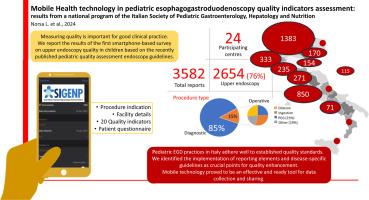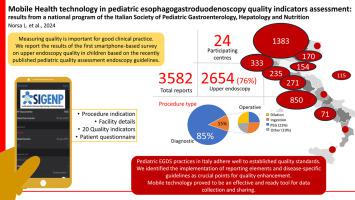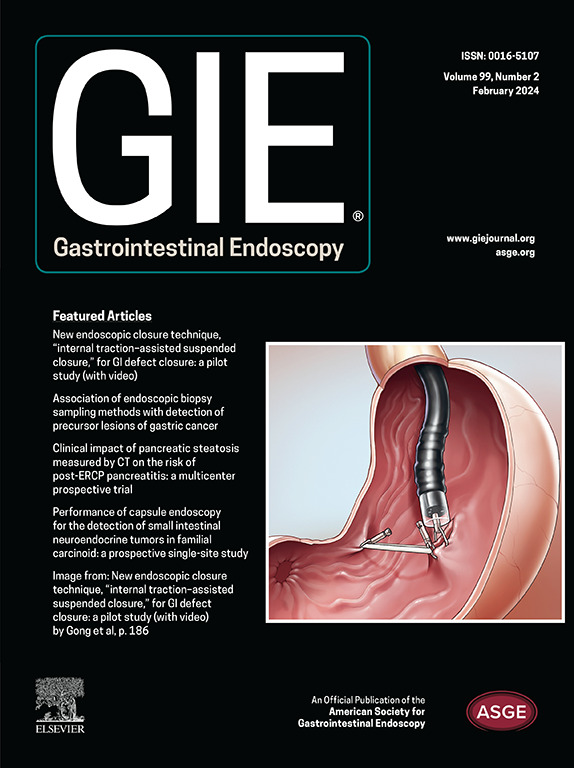移动医疗技术在儿科食管胃十二指肠镜检查质量指标评估中的应用:意大利儿科胃肠病学、肝脏病学和营养学会全国计划的成果。
IF 6.7
1区 医学
Q1 GASTROENTEROLOGY & HEPATOLOGY
引用次数: 0
摘要
背景和目的:上消化道内镜检查(UEP、食管胃十二指肠镜[EGDS]和逆行内镜逆行胰胆管造影[ERCP])是儿科消化内科的既定标准护理。儿科内镜检查质量改进网络(PEnQuIN)最近发布了儿科专用内镜检查质量指南。本研究由意大利儿科胃肠病学、肝病学和营养学学会(SIGENP)发起,旨在评估意大利儿科内镜中心对这些既定质量标准的遵守情况:这项全国性研究于 2019 年 4 月至 2021 年 3 月间进行,采用了基于智能手机应用程序的方法。研究系统地收集了包括儿科内窥镜检查设施、患者资料、内窥镜检查适应症、17 项与手术相关的 PEnQuIN 指标以及 GHAA-9m 患者满意度调查问卷在内的数据:结果:对 24 家儿童内镜中心的 3582 例手术进行的综合分析表明,2654 例(76%)属于 UEP。大多数中心(75%)都有一名以上的操作人员参与,其中有 9 个 PEC 包含成人内镜医师,负责 5% 的 UEP。总体而言,对质量标准的遵守情况良好;但是,需要改进的方面包括镇静细节的报告不够理想、对特定疾病指南的遵守情况以及患者满意度调查问卷的完整性(56%)。并发症发生率符合文献标准(1%),患者满意度普遍较高。值得注意的是,在COVID-19疫情爆发后,每月报告率下降了30%,特定疾病模式也发生了变化:结论:意大利的儿科 UEP 实践很好地遵守了既定的质量标准。强调采用特定疾病指南对于优化资源、提高诊断准确性和减少不必要的程序至关重要。优先考虑患者的满意度对于立即改进实践和未来的研究工作都很重要。本文章由计算机程序翻译,如有差异,请以英文原文为准。


Mobile health technology in pediatric EGD quality indicators assessment: results from a national program of the Italian Society of Pediatric Gastroenterology, Hepatology and Nutrition
Background and Aims
Upper endoscopy (UE) procedures (EGD and ERCP) are an established standard of care in pediatric gastroenterology. The Pediatric Endoscopy Quality Improvement Network (PEnQuIN) recently published its pediatric-specific endoscopy quality guidelines. This study, initiated by the Italian Society of Pediatric Gastroenterology, Hepatology and Nutrition, aims to evaluate the adherence of Italian pediatric endoscopy centers (PECs) to these established quality standards.
Methods
Conducted between April 2019 and March 2021, this nationwide study used a smartphone–based app approach. Data encompassing pediatric endoscopy facilities, patient profiles, endoscopy indications, 17 procedure-related PEnQuIN indicators, and a patient satisfaction questionnaire (Group Health Association of America-9) were systematically collected.
Results
A comprehensive analysis of 3582 procedures from 24 centers revealed that 2654 (76%) were UEs. The majority of centers (75%) involved >1 operator, with 9 centers incorporating adult endoscopists, responsible for 5% of UEs. Overall, adherence to quality standards was good; however, areas of improvement include suboptimal reporting of sedation details, adherence to disease-specific guidelines, and patient satisfaction questionnaire completeness (56%). The adverse event rate aligned with literature standards (1%), and patient satisfaction was generally high. A noteworthy observation was a 30% decreased monthly reporting rate and a shift in disease-specific patterns after the COVID-19 outbreak.
Conclusions
Pediatric UE practices in Italy adhere well to established quality standards. Emphasizing the adoption of disease-specific guidelines is crucial for optimizing resources, enhancing diagnostic accuracy, and minimizing unnecessary procedures. Prioritizing patient satisfaction is important for immediate enhancements in practice as well as for future research endeavors.
求助全文
通过发布文献求助,成功后即可免费获取论文全文。
去求助
来源期刊

Gastrointestinal endoscopy
医学-胃肠肝病学
CiteScore
10.30
自引率
7.80%
发文量
1441
审稿时长
38 days
期刊介绍:
Gastrointestinal Endoscopy is a journal publishing original, peer-reviewed articles on endoscopic procedures for studying, diagnosing, and treating digestive diseases. It covers outcomes research, prospective studies, and controlled trials of new endoscopic instruments and treatment methods. The online features include full-text articles, video and audio clips, and MEDLINE links. The journal serves as an international forum for the latest developments in the specialty, offering challenging reports from authorities worldwide. It also publishes abstracts of significant articles from other clinical publications, accompanied by expert commentaries.
 求助内容:
求助内容: 应助结果提醒方式:
应助结果提醒方式:


